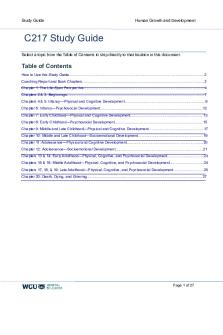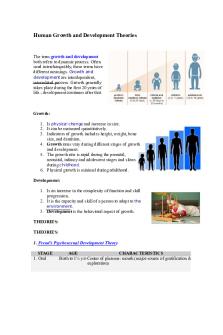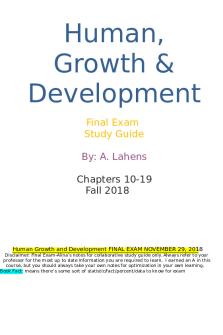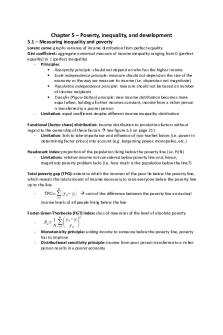Human growth and development PDF

| Title | Human growth and development |
|---|---|
| Author | Mitchy Kay |
| Course | Introduction to Human Psychology |
| Institution | University of the People |
| Pages | 46 |
| File Size | 617.4 KB |
| File Type | |
| Total Downloads | 12 |
| Total Views | 156 |
Summary
detailed notes on human growth and development majoring on introduction to lifecycle development ...
Description
HUMAN GROWTH AND DEVELOPMENT: INTRODUCTION TO LIFECYCLE Definition: Human growth and development refers to change or growth that occurs in human beings with age. It starts with infancy and continues to adulthood. The scientific study of changes in human behavior and mental processes in the process of development is referred to as developmental psychology. Changes in human development are often divided into three main areas. These include physical, cognitive, and social-emotional development. Dividing development into these areas makes it easier to study. Areas of Human Growth and Development 1. Physical Development In this section we will discuss physical development. This refers to physical body changes which occur in a relatively stable, predictable sequence and in an orderly manner. These changes include; changes in bone thickness, vision, hearing, and muscle. Height and weight also form part of it. Actually, height and weight are the most obvious signs of physical development. Physical skills, such as crawling, walking, and writing, are the result of physical development.These skills fall into two main categories: Gross-motor development which involves improvement of skills using the large muscles in the legs and arms. Such activities as running, skipping, and bike riding fall into this category. Fine-motor development involves the small muscles of the hands and fingers. Grasping, holding, cutting, and drawing are some activities that require fine motor development. Environmental factors may affect what children can do physically. These factors include proper nutrition and appropriate toys and activities. It is possible to find children of the same age but whose physical development is obviously different. This can be brought about by the genetical make up as well as the environmental factors. 2. Cognitive Development This refers to processes people use to gain knowledge. This includes; Language, thought, reasoning, and imagination are all included. Identifying colors and knowing the difference between one and many are examples of cognitive tasks. Language and thought are a result of cognitive development. These two skills are closely related. Both are needed for planning, remembering, and problem solving. As children mature and gain experience with their world, these skills develop. Children are born with the potential for cognitive process that unfolds as they mature. 0-2 years develop schemas enabling them to separate themselves as observers from the objects in the environment hence object permanence. They start learning language. 3-4years play about with symbols. Logical thinking starts developing from age 4 years as concrete
operation and later during and after adolescence as formal operation. Creative thinking (fluid intelligence increases with age to mid adulthood and then starts declining while experiential intelligence (Crystalized intelligence) increase but the rate of increasing reduces at old age. s 3. Social and Emotional Development Social-emotional development includes the child’s experience, expression, and management of emotions and the ability to establish positive and rewarding relationships with others (Cohen and others 2005). It encompasses both intra- and interpersonal processes. Social development refers to child's ability to make and maintain relationships. The core features of emotional development include the ability to identify and understand one’s own feelings, to accurately read and comprehend emotional states in others, to manage strong emotions and their expression in a constructive manner, to regulate one’s own behavior, to develop empathy for others, and to establish and maintain relationships. (National Scientific Council on the Developing Child 2004, 2) In learning to recognize, label, manage, and communicate their emotions and to perceive and attempt to understand the emotions of others, children build skills that connect them with family, peers, teachers, and the community. These growing capacities help young children to become competent in negotiating increasingly complex social interactions, to participate effectively in relationships and group activities, and to reap the benefits of social support crucial to healthy human development and functioning. Research has revealed that during pregnancy children are in contact with the external environment through their senses and these experiences influence how they respond to social contexts later in life. After birth neonates 0-1yr develop primary attachment with the care giver. This attachment can be secure (healthy) or insecure (insecure). A secure attachment; 1) Promotes a positive relationship between a child and caregiver, 2) Decreases risk for social and emotional problems later in childhood and adulthood, 3) Encourages healthy relationships outside the home (e.g., child-care providers, friends, other adults) and 4) Fosters positive, trusting relationships in middle childhood, adolescence, and adulthood. Infants experience, express, and perceive emotions before they fully understand them. A 2-3 months old infant is soothed and smiles at the voice of an adult. When the caregiver talks to the child, he/she will fixate on the face of the loved one. Engages sensorimotor play to discover themselves. 3-6 months an infant smiles spontaneously show primary emotions and engage in solitary play. 6-9 months infants show wider emotional range and is selective preferring familiar people. 9-12 months show anxiety when separated from caregiver, imitates and self regulates. Engages in parallel play. 1-2 years develops strong sense of self and direct others to do things. Develops basic emotional vocabularies and they self-assert. 3-4 years develop interest in other children. They initiate and join in play with others and share. Social play develops. 5-7 years intensifies social play. They develop friendships and enjoy being with friends. They identify their
gender and start learning gender roles. 7-11yrs develop competence. They engage in competition play. They understand rules and regulations and abide to maintain order in play and friendship groups. 12-19 experiences emotional imbalance, friends become more important they value privacy and freedom develop personal principles and self-identity. 20-35yrs emotionally differentiate with family members and gain socio-economic independence and engage in wide variety of relationships in family, workplace friendship etc. They gain emotional stability and have a variety of problem solving skills. 35-65yrs work and family relationships become central. Are calm and are experienced in problem solving not only in the family but in the society as well. 65+ change of roles where they change from caregiving to being taken care of. They revisit past relationships and seek to mend fences. They return back to families and deal with losses of abilities and relationships. A child cooperates with others during early childhood and begins to develop conflict resolution skills while emotional development, on the other hand, involves feelings and expression of feelings Strategies of improving social-emotional development in children
Lead by example, by modeling positive behaviors
Be affectionate
Be considerate of feelings, wants and needs
Express interest in daily activities
Respect their viewpoints
Express pride in accomplishments
Provide encouragement and support during times of stress
Nature Versus Nurture Our behaviours depend as much on nature as it does on the environment in which your child is reared. This concept is referred to as "nature versus nurture." Genetic makeup is inherited from his parents and set at conception. These genetic traits determine the potential for such matters as height and general muscle development; this is nature's influence. A gene is the basic physical and functional unit of heredity. Genes, which are made up of DNA, act as instructions to make molecules called proteins. In humans, genes vary in size from a few hundred DNA bases to more than 2 million bases. The Human Genome Project has estimated that humans have between 20,000 and 25,000 genes. Every person has two copies of each gene, one inherited from each parent. Most genes are the same in all people, but a small number of genes (less than 1 percent of
the total) are slightly different between people. Alleles are forms of the same gene with small differences in their sequence of DNA bases. These small differences contribute to each person’s unique physical features. Genetical predisposition can be explained in two ways: genotype and phenotype. GENOTYPE" is an organism's full hereditary information. "Phenotype" is an organism's actual observed properties, such as morphology, development, or behavior. Nurture: a person’s environment and experiences, influences our behaviours. We learn behavior from our environment through classical conditioning, operant conditioning and social learning because his environment is the framework in which we physically interact with the world. Principles of Development In the other sections we looked at areas of development and acknowledged that children are unique and may not develp in exactly the same way. Although each child is unique, the basic patterns, or principles, of growth and development are universal, predictable, and orderly. We shall hereby discuss the principles of child development that make development follow a predictable pattern. Knowledge of the principles of development help you; Understand that the order or sequence of development in children is generally the same. However, each child develops at his or her own rate. Observe what abilities each child has gained. Plan appropriate activities that aid children in successfully developing new skills Through careful observation and interaction with children, researchers and those who work with children understand the characteristics of the principles that follow. a. Cephalocaudal principle: Development tends to proceed from the head downward. According to this principle, the child first gains control of the head, then the arms, then the legs. Infants gain control of head and face movements within the first two months after birth. In the next few months, they are able to lift themselves up using their arms. By 6 to 12 months of age, infants start to gain leg control and may be able to crawl, stand, or walk. b. Proximodistal principle: Development also proceeds from the center of the body outward according to the In this case, the spinal cord develops before other parts of the body. The child’s arms develop before the hands, and the hands and feet develop before the fingers and toes. Fingers and toes are the last to develop. c. Principle of maturation: Maturation refers to the sequence of biological changes in children. These orderly changes give children new abilities. Much of the maturation depends on changes in the brain and the nervous system. These changes assist children to improve their thinking abilities and motor skills. A rich learning environment helps children develop to their potential. Children must mature to a certain point before they can gain some skills, For instance, the brain of a four-month-old has not matured enough to allow the child to use words. A four-month-old will babble and coo. However, by two years of age, with the help of others, the child will be able to say and understand
many words. This is an example of how cognitive development occurs from simple tasks to more complex tasks. Likewise, physical skills develop from general to specific movements. For example, think about the way an infant waves its arms and legs. In a young infant, these movements are random. In several months, the infant will likely be able to grab a block with his or her whole hand. In a little more time, the same infant will grasp a block with the thumb and forefinger. Research in Human Growth and Development The physical, cognitive, social, and emotional growth that takes place though life sets the foundation for success or failure in learning and life. Research in Human growth and development is therefore important since with that knowledge, you can better identify, interpret, and respond to a individual differences. Whatever your field, you’ll be prepared to respond effectively to the needs, challenges, and capacities of children and their families, helping them get the best start in life. Measurement Techniques Used in Developmental Research We will now look at the various methods used in research with human growth and development. The first task a developmental psychology researcher has is to decide on a research method by which to collect information. No matter which method is used, it the research should be conducted according to scientifically accepted procedures. The type of method the researcher chooses is driven by several factors:
The hypothesis that is being tested or the research question that is being asked The type of information that is being gathered, how the study is designed The number of participants. Any ethical considerations that relate to the participants.
Scientific inquiries are categorized into two broad categories: qualitative methods and quantitative methods. Qualitative methods employ nonnumeric designs and attempt to study phenomena inductively, as a process, and in the place in which the phenomena occur. Quantitative approaches on the other hand measure phenomena numerically and deduce conclusions from the numeric data. Both approaches are well represented in the study of children. Let us first discuss the qualitative methods in this section. Types of Qualitative Methods The major types of qualitative methods include observation, self-report, and case study. i. Observation There are two ways of carrying out observation. The first involves viewing the subject of interest in a laboratory setting. The benefit of this is that the situation can be controlled by the researcher.
The drawbacks of this kind observation are that the setting can be unnatural and the subject is aware that they are being studied and hence can be artificial in their behavior. The second allows researchers to observe participants in real-world settings (naturalistic observation). The strength of this method is that it allows researchers to view behavior as it really happens in a natural setting. In conducting a naturalistic observation, the researcher observes behavior in a natural environment, such as in a home, day-care, or school setting. The drawback is that the researcher cannot control outside variables that might impact behavior. ii. Self-reports Self-reports can also be used to gather information qualitatively. There are two forms of self reports. 1) The first is the interview method, in which the researcher poses questions to participants either in informal or formal settings as he/she records the responses. These may include direct interviews, focus group discussions or even telephone interviews. 2) The second form is the self-report instrument, in which participants respond to a questionnaire or some other type of structured instrument. Both forms have advantages and disadvantages. Advantages The advantages of self-reports include;
Structured instruments provide control over external and extraneous stimuli. This means that the there is less interference of other variables that are not necessary for the research. Permit comparisons of the responses, and aid in efficient data collection. Interviews may provide richer information and could tap aspects of the participants that go unmeasured in structured instruments, such as how the participants think and function in the natural setting.
Disadvantages
Self reports limit generalization of results. Results of the open interview are difficult touse for comparison purposes among individuals or groups of individuals. The rich data gained through interviews could come at the cost of standardization, thereby ruling out comparisons across participant responses.
iii. Case Study The third qualitative method of research is the clinical method, or case study. The case study allows the researcher to gain detailed information on one individual's development. The rich data provides an extensive picture of the developmental process of an individual. In turn this means that there is only one person in the study and that any conclusions that are drawn cannot be easily generalized to other individuals. Types of Quantitative methods
There are three types of commonly used quantitative methods of study:
Correlational Experimental, Quasi-Experimental.
To some degree each of these designs allows the researcher to identify relationships between different factors and to then specify the causes of these relationships. Let us discuss each of the three methods singly. i. Correlational design: Correlational design is used to determine whether relationships exist between two or more variables. In most cases the investigator intends to determine whether a change in one variable coincides with a change in a second variable. In a correlation design no variable manipulation occurs. For example, a child's behaviors are measured as they occur naturally and a numerical index reflecting the relationship between the measures' outcomes is then computed. Usually, a correlation coefficient is used to calculate the strength and type (positive or negative) of relationship that exists. Although the correlational design is extremely useful, it cannot be used to determine cause-effect relationships between variables. This is because variables other than the ones under study cannot be controlled, measured, or otherwise considered in this design; such variables could influence the relationship between the variables under study. This kind of control is afforded only in designs in which variables can be manipulated and participants can be randomly assigned to groups. Correlational research methods are common in the study of development partly because ethical concerns in research with human beings. ii. Experimental design: Experimental designs allow cause-effect conclusions unlike correlational designs. This is because variables can be manipulated and participants can be randomly assigned. With respect to manipulation of variables, the researcher must assign independent and dependent variables to the experiment. The independent variables are the ones manipulated by the researcher while the dependent variable represents the responses of the participants. For example, an independent variable might represent the amount of direct reading instruction students receive, and the dependent variable might be reading achievement scores. In essence, the researcher wants the dependent variable to reflect the effect of being treated with the independent variable. Experiment is the most scientific method of research. However, it can be difficult to use if the variables of interest are abstract or internal concepts. Another problem is that some variables of interest cannot be studied through experimentation for ethical reasons. Examples of this would be research on the effects of child abuse on development. One cannot expose children to abuse to find out its effect on the children. iii. Quasi- experimental designs
These are not true experiments. Since true experiments may have ethical issues, researchers in child psychology as in other areas in social science carry out quasi-experiments Developmental psychologists are mostly concerned with the changes in children that occur over a period of time e.g. the first five years of life. This fact brings to light another research design choice that must be considered: longitudinal research versus cross-sectional research. Let us now delve into these two research designs. Longitudinal research Longitudinal studies involve studying the same group of participants over a particular time period. In a longitudinal study, a researcher performs repeated observations or testing at specified points during the participants' lives, thus allow...
Similar Free PDFs

Human growth and development
- 46 Pages

EPC 202 Human Growth AND Development
- 28 Pages

Growth and Development Notes
- 10 Pages

Growth and development chart
- 9 Pages

Growth & Development
- 4 Pages

Growth and Development CH01 exam
- 40 Pages

Growth and Development CH03 TB
- 41 Pages
Popular Institutions
- Tinajero National High School - Annex
- Politeknik Caltex Riau
- Yokohama City University
- SGT University
- University of Al-Qadisiyah
- Divine Word College of Vigan
- Techniek College Rotterdam
- Universidade de Santiago
- Universiti Teknologi MARA Cawangan Johor Kampus Pasir Gudang
- Poltekkes Kemenkes Yogyakarta
- Baguio City National High School
- Colegio san marcos
- preparatoria uno
- Centro de Bachillerato Tecnológico Industrial y de Servicios No. 107
- Dalian Maritime University
- Quang Trung Secondary School
- Colegio Tecnológico en Informática
- Corporación Regional de Educación Superior
- Grupo CEDVA
- Dar Al Uloom University
- Centro de Estudios Preuniversitarios de la Universidad Nacional de Ingeniería
- 上智大学
- Aakash International School, Nuna Majara
- San Felipe Neri Catholic School
- Kang Chiao International School - New Taipei City
- Misamis Occidental National High School
- Institución Educativa Escuela Normal Juan Ladrilleros
- Kolehiyo ng Pantukan
- Batanes State College
- Instituto Continental
- Sekolah Menengah Kejuruan Kesehatan Kaltara (Tarakan)
- Colegio de La Inmaculada Concepcion - Cebu








